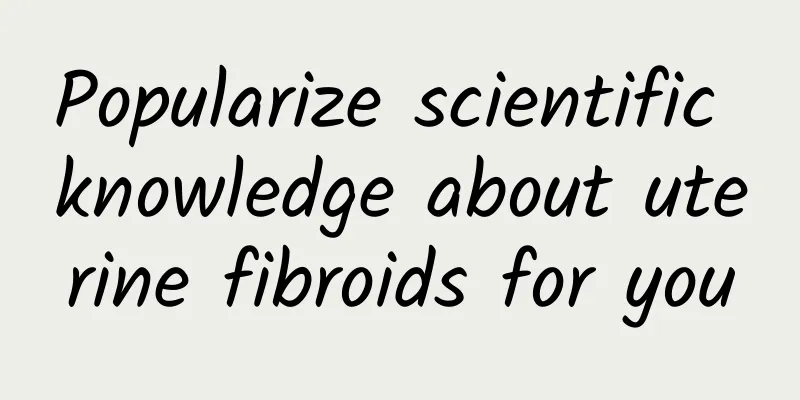Popularize scientific knowledge about uterine fibroids for you

|
Uterine fibroids are benign tumors that occur in the smooth muscle tissue of the uterus and are composed of smooth muscle and connective tissue. They are common in women aged 30-50 years old. The specific cause of the disease is unclear and may be directly related to female sex hormones and genetic factors. The symptoms of general patients are not obvious. Some patients have symptoms such as abdominal pain, abnormal menstruation, increased leucorrhea, constipation caused by tumor compression, and frequent urination. For uterine fibroids, the appropriate treatment plan is selected based on the patient's symptoms, age, and location of the fibroids. Uterine fibroids are treated with drugs and surgery, which can control the growth of the tumor, remove the tumor, and have a good treatment effect. For patients with fertility needs, regular treatment is carried out in a timely manner to retain fertility. However, if active treatment is not carried out, it will lead to a decline in the quality of life, and complications such as infection, anemia, and acute abdomen. Uterine fibroids treatment The treatment plan is determined based on the actual location, size, and number of uterine fibroids, the patient's symptoms, age, whether she has fertility requirements, and whether she is approaching menopause. The treatment method can be to follow up the patient regularly, use medication, or undergo surgery. Ensure that the patient lives a normal life and relieve discomfort. The basic treatment goal of uterine fibroids is to effectively control and remove the tumor to avoid affecting the patient's normal life. 1. Drug treatment It is suitable for patients with milder symptoms, those approaching menopause, those undergoing preoperative preparation, or those who are in severe general discomfort and are not suitable for surgery. 1. Injection of medication Injection of gonadotropin-releasing hormone drugs: reduce estrogen levels, effectively relieve the patient's symptoms, and inhibit the growth of uterine fibroids. Side effects may rebound after discontinuation of the drug, causing perimenopausal syndrome. Common symptoms include changes in menstrual cycles and decreased menstrual volume. Long-term use may cause osteoporosis in patients, and long-term medication treatment is not recommended. 2. Oral medication (1) Mifepristone: Mainly used for preoperative preparation and early menopausal patients. The side effect is an increased risk of endometrial lesions and is not suitable for long-term use. (2) Others: Unconventional use of drugs, such as hemostatics, nonsteroidal anti-inflammatory drugs, and combined oral contraceptives, to provide symptomatic treatment for patients. 2. Surgical treatment 1. Myomectomy: Uterine fibroids are removed by transabdominal, transvaginal, or hysteroscopic methods to effectively preserve the uterus. Suitable for patients who want to preserve their fertility. Although they do not have fertility requirements, they strongly hope to preserve their uterus. The risk of this surgery is postoperative recurrence and residual fibroids. If pregnant, it may cause the risk of uterine rupture during pregnancy. 2. Hysterectomy: Suitable for patients who want to preserve their fertility without spending money and who are suspected of malignant transformation. The surgical methods are also hysteroscopy, vaginal, abdominal, and laparoscopy. Compared with myomectomy, this surgical method is relatively more invasive and may cause patients to face greater psychological pressure. 3. Other treatments 1. Uterine artery embolization: Blocking the blood supply to the tumor artery can slow the growth of the tumor and relieve the patient's symptoms. The risk is ovarian dysfunction and potential pregnancy complications. This surgical method is not recommended for women who want to have children. 2. High-energy focused ultrasound and microwave ablation: Physically necrotize and scar the fibroid tissue, but the risk is residual fibroids and possible recurrence. This treatment requires the exclusion of the possibility of malignant diseases. 3. Endometrial resection: Resection of the endometrium through hysteroscopy to reduce menstrual volume or cause amenorrhea. Uterine fibroids daily precautions 1. Self-monitoring for symptoms Pay attention to the menstrual cycle, menstrual volume, and whether there is abdominal pain. Check whether there is increased vaginal discharge, vaginal bleeding, or odorous discharge during the non-menstrual period. Perform ultrasound examinations and conduct regular ultrasound reexaminations to monitor the condition of the tumor. 2. Daily Diet Increase the variety of food appropriately, ensure balanced nutrition, and eat more fresh fruits and vegetables. If patients with uterine fibroids have menstrual disorders, they may be prone to anemia, so they should consume iron-containing foods such as pig blood, duck blood, and green vegetables. 3. Exercise Develop good exercise habits and choose the kind of exercise you are interested in, such as ball games, yoga, and running. Those who lack exercise should start gradually. If you feel uncomfortable or the tumor is large, avoid strenuous exercise. 4. Prevention points Daily prevention requires the formation of good living habits, regular screening of high-risk groups, and early detection and treatment. (1) Avoid abusing drugs and health products Women suffering from uterine fibroids may have a direct relationship with female hormones. In daily life, we should avoid abusing health products and hormone drugs. (2) Control your weight and avoid being overweight or obese Maintain a normal weight through moderate exercise and a proper diet. (3) Early intervention for high-risk groups Patients with a family history, hormone replacement therapy, and PCOS need to undergo regular physical examinations. If any abnormalities occur, they should be discovered as early as possible and treated proactively. (Zhao Li, the Third People's Hospital of Xinjiang Uygur Autonomous Region) |
<<: Collection! Peking University People's Hospital Breast Cancer Nanny-level Treatment Guide
>>: How much do you know about the care of hemodialysis lifeline?
Recommend
What causes vulvar itching and how to treat it?
Excessive sweating, moisture and immersion in the...
QuestMobile: Top 50 WeChat Mini Programs with the Most Users in China in Spring 2024
QuestMobile recently released the "2024 Chin...
What to do if you have lower abdominal pain after medical abortion
Medical abortion can cause lower abdominal pain b...
A paralyzed patient was admitted to the anorectal surgery department? Be careful, constipation may also be life-threatening!
Recently, Ms. Li (pseudonym), a patient with lowe...
B ultrasound showed no fetal heart rate
During the B-ultrasound examination, if no fetal ...
Can a woman who is six months pregnant have an abortion?
We all know that pregnancy is a difficult thing f...
Can plaque in blood vessels cause stroke?
□ Science Popularization Times reporter Li Liyun ...
Can I have a baby with uterine fibroids?
For women with uterine fibroids, their fertility ...
Pain on both sides of the abdomen during pregnancy
During pregnancy, women will experience various h...
What should women eat if they are calcium deficient?
Calcium is an important element for maintaining o...
What are the benefits of eating hawthorn to lose weight? Can hawthorn be refrigerated?
Hawthorn's special color, fragrance and taste...
What are the symptoms of pregnancy during the luteal phase?
The follicular phase is a period of safe menstrua...
Causes of weight loss during breastfeeding
We say that many mothers are very good. They don&...
What should I do if I have breast pain before my period?
Breast pain before menstruation is a common pheno...
How to massage breast enhancement effect, bath massage
Small breasts are one of the worries of many girl...









